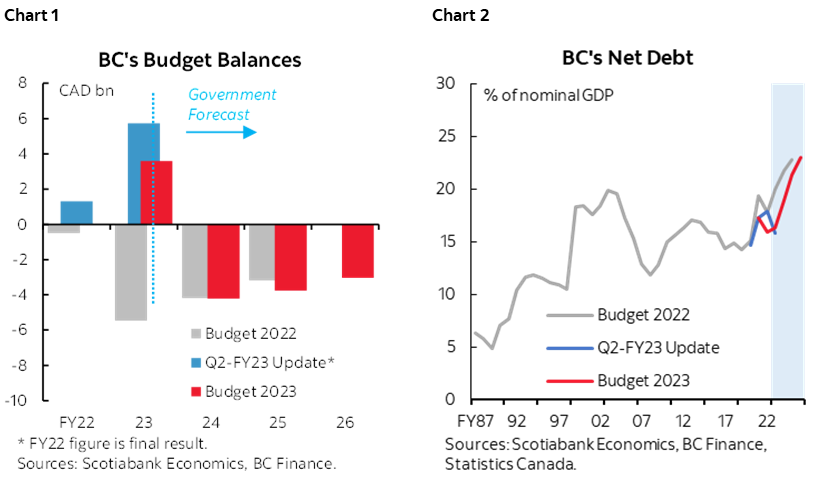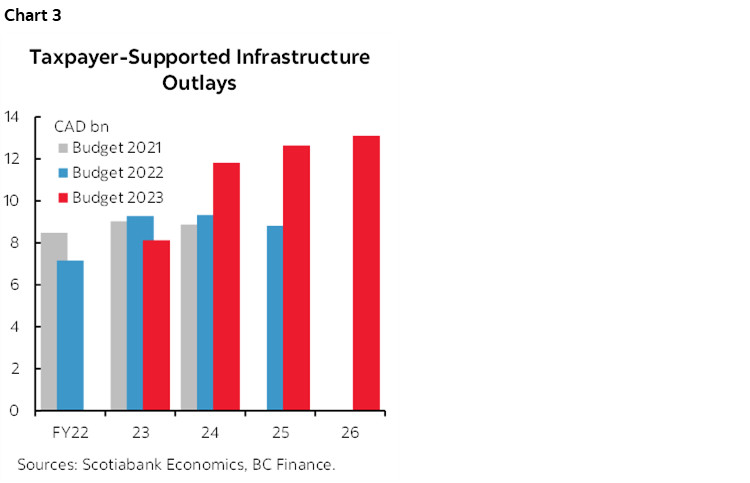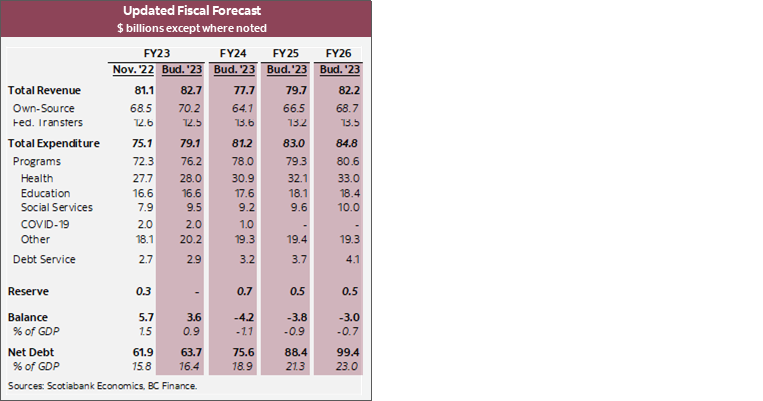RETURN OF THE DEFICITS
- Budget balance forecasts: $3.6 bn (0.9% of nominal GDP) in FY23, -$4.2 bn (-1.1%) in FY24, -$3.8 bn (-0.9%) in FY25, and -$3.0 bn (-0.7%) in FY26 (chart 1).
- Net debt: revised up slightly relative to the mid-year update as a share of nominal output; the net debt-to-GDP ratio is now expected to increase steadily from 16.4% in FY23 to 23.0% by FY25 (chart 2).
- Real GDP growth forecast: +2.8% in 2022, +0.4% in 2023, and +1.5% in 2024—a lower trajectory than forecast in Budget 2022 reflecting the impact of higher interest rates.
- New borrowing: $8.7 bn in FY23, $18.9 bn in FY24, $20.4 bn in FY25, and $19.3 bn in FY26.
- The bulk of new discretionary spending ($8.7 bn or 2% of nominal GDP) targets healthcare and housing affordability for FY24–26, while there is also a hefty $7.6 bn (1.9% of GDP) allotted for recently negotiated public-sector wage hikes.
- The budget also announced new and enhanced tax measures with an estimated cost of $4.5 bn between FY24 and FY26, aiming to provide cost-of-living relief through an enhanced Climate Action Tax Credit and the long-promised Renter’s Tax Credit.
- The return to deficits has been largely expected as the province faces one of the sharpest downturns in the country, but the budget largely contains new discretionary spending to the highest priorities and constrain the affordability support measures. BC still has the advantage of a lower net debt burden than most of its peers, combined with the substantial prudence built into its budget, giving it some leeway as the province navigates through the near-term challenges.

OUR TAKE
In BC’s Budget 2023, the province’s projected near-term fiscal position weakened slightly relative to its fall update, and the FY24–25 balance forecasts remain close to last budget’s estimates. The province now estimates a surplus in FY23 at $3.6 bn (0.9% of nominal GDP), down from $5.7 bn (1.5%) expected in the fall update, and maintains the projected deterioration in FY24 to a modest deficit of -1.1% of GDP. As widely anticipated, revenue windfalls are set to unwind rapidly as the impact of rising interest rates disproportionally affects the province, driving tax revenue lower by -10.6% in FY24 relative to FY23, combined with a -21.4% drop in natural resource revenue. The shortfall is expected to narrow to -0.7% of GDP by FY26 owing to projected improvements in tax revenue as the economic rebound takes hold.
The Budget announced $8.7 bn (around 2% of nominal GDP) targeted new spending over FY24–26, with healthcare and housing-related investments comprising the bulk of expenditure increases. Over 70% of new spending goes to improving the health care system and mental health, which are roughly evenly split across the three years. The BC government also stepped up its investments in housing affordability—long identified as a major vulnerability in the province—with $2.2 bn in operating investments and another $4.2 bn in capital investments. The new housing initiatives focus on facilitating supply instead of demand—wisely in our view—with the exception of the Renter’s Tax Credit, which totals $939 mn over three years and provides support to households with income up to $60k. Increases in new affordability support measures seem relatively contained at $1.3 bn over three years providing support to students and those on income and disability assistance. Another major spending item announced in the Budget is the hefty $7.6 bn (1.9% of GDP) over three years planned for public-sector wage increases, further weighing on the province’s bottom line.
This budget continues to build in prudence in forms of conservative planning assumptions, forecast allowance and abundant contingencies. Real GDP is projected to grow 2.8% in 2022, 0.4% in 2023 and 1.5% in 2024, 0.1–0.2 ppts lower than forecasts provided by the Economic Forecast Council for each year. The budget acknowledges the material downside risks to the near-term economic outlook by pencilling in a forecast allowance of $700 mn in FY24 and another $500 mn each year for FY25 and FY26—equivalent to the fiscal impact of around 2–3 ppts decrease in nominal GDP. In addition, BC’s updated blueprint continues to include substantial contingencies in case of future spending needs, incorporating a sizable buffer of $5.5 bn in contingencies in FY24, $5.3 bn in FY25 and $4.7 bn in FY26. Hence, the province likely has the capacity to absorb significant downside risks, while unallocated contingencies also provide some flexibility to deliver narrower deficits in outer years should stronger growth transpire.
The capital spending outlook in BC for FY24 has been revised up substantially in outer years as the government looks to spend more on health and transportation. Taxpayer-supported capital spending was lower in FY23 ($8.1 bn) than what was set out in Budget 2022 ($9.3 bn) but will increase to over $11.5 bn per year beginning in FY24, totalling $37.5 bn over the next three years (chart 3). Health and transportation initiatives will combine for over 60% of taxpayer-supported capital spending each year.

BC’s borrowing program is expected to pick up in light of stepped-up capital spending and anticipated deficits. New borrowing requirements are expected to jump from $8.7 bn in FY23 to $18.9 bn in FY24, and continue to grow to $20.4 bn in FY25 and $19.3 bn in FY26. The slowing nominal growth and projected deterioration in budget balances sent the net debt-to-GDP ratio on an upward trajectory, yet on a lower path compared to in last year’s budget and from a very low starting point.

DISCLAIMER
This report has been prepared by Scotiabank Economics as a resource for the clients of Scotiabank. Opinions, estimates and projections contained herein are our own as of the date hereof and are subject to change without notice. The information and opinions contained herein have been compiled or arrived at from sources believed reliable but no representation or warranty, express or implied, is made as to their accuracy or completeness. Neither Scotiabank nor any of its officers, directors, partners, employees or affiliates accepts any liability whatsoever for any direct or consequential loss arising from any use of this report or its contents.
These reports are provided to you for informational purposes only. This report is not, and is not constructed as, an offer to sell or solicitation of any offer to buy any financial instrument, nor shall this report be construed as an opinion as to whether you should enter into any swap or trading strategy involving a swap or any other transaction. The information contained in this report is not intended to be, and does not constitute, a recommendation of a swap or trading strategy involving a swap within the meaning of U.S. Commodity Futures Trading Commission Regulation 23.434 and Appendix A thereto. This material is not intended to be individually tailored to your needs or characteristics and should not be viewed as a “call to action” or suggestion that you enter into a swap or trading strategy involving a swap or any other transaction. Scotiabank may engage in transactions in a manner inconsistent with the views discussed this report and may have positions, or be in the process of acquiring or disposing of positions, referred to in this report.
Scotiabank, its affiliates and any of their respective officers, directors and employees may from time to time take positions in currencies, act as managers, co-managers or underwriters of a public offering or act as principals or agents, deal in, own or act as market makers or advisors, brokers or commercial and/or investment bankers in relation to securities or related derivatives. As a result of these actions, Scotiabank may receive remuneration. All Scotiabank products and services are subject to the terms of applicable agreements and local regulations. Officers, directors and employees of Scotiabank and its affiliates may serve as directors of corporations.
Any securities discussed in this report may not be suitable for all investors. Scotiabank recommends that investors independently evaluate any issuer and security discussed in this report, and consult with any advisors they deem necessary prior to making any investment.
This report and all information, opinions and conclusions contained in it are protected by copyright. This information may not be reproduced without the prior express written consent of Scotiabank.
™ Trademark of The Bank of Nova Scotia. Used under license, where applicable.
Scotiabank, together with “Global Banking and Markets”, is a marketing name for the global corporate and investment banking and capital markets businesses of The Bank of Nova Scotia and certain of its affiliates in the countries where they operate, including; Scotiabank Europe plc; Scotiabank (Ireland) Designated Activity Company; Scotiabank Inverlat S.A., Institución de Banca Múltiple, Grupo Financiero Scotiabank Inverlat, Scotia Inverlat Casa de Bolsa, S.A. de C.V., Grupo Financiero Scotiabank Inverlat, Scotia Inverlat Derivados S.A. de C.V. – all members of the Scotiabank group and authorized users of the Scotiabank mark. The Bank of Nova Scotia is incorporated in Canada with limited liability and is authorised and regulated by the Office of the Superintendent of Financial Institutions Canada. The Bank of Nova Scotia is authorized by the UK Prudential Regulation Authority and is subject to regulation by the UK Financial Conduct Authority and limited regulation by the UK Prudential Regulation Authority. Details about the extent of The Bank of Nova Scotia's regulation by the UK Prudential Regulation Authority are available from us on request. Scotiabank Europe plc is authorized by the UK Prudential Regulation Authority and regulated by the UK Financial Conduct Authority and the UK Prudential Regulation Authority.
Scotiabank Inverlat, S.A., Scotia Inverlat Casa de Bolsa, S.A. de C.V, Grupo Financiero Scotiabank Inverlat, and Scotia Inverlat Derivados, S.A. de C.V., are each authorized and regulated by the Mexican financial authorities.
Not all products and services are offered in all jurisdictions. Services described are available in jurisdictions where permitted by law.

